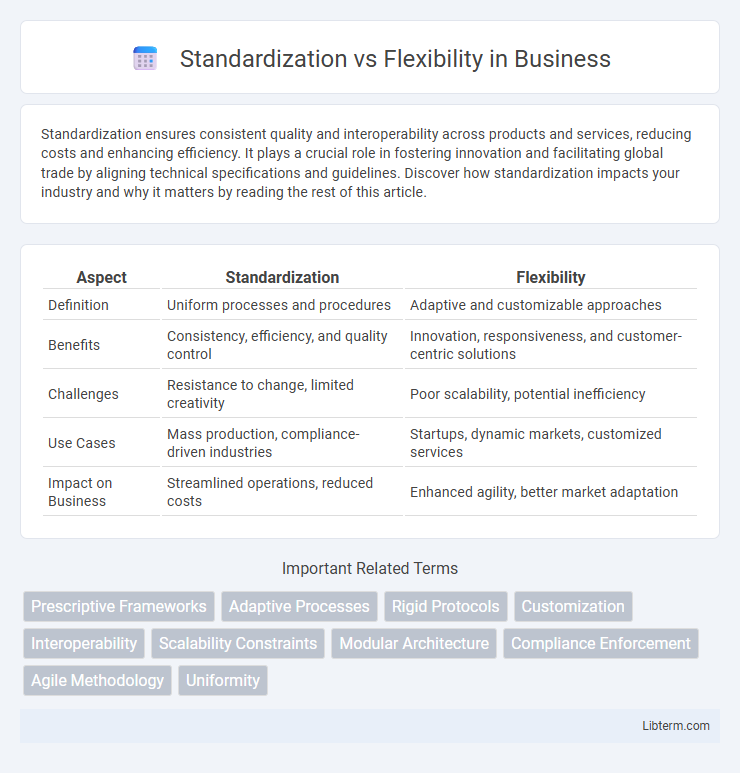Standardization ensures consistent quality and interoperability across products and services, reducing costs and enhancing efficiency. It plays a crucial role in fostering innovation and facilitating global trade by aligning technical specifications and guidelines. Discover how standardization impacts your industry and why it matters by reading the rest of this article.
Table of Comparison
| Aspect | Standardization | Flexibility |
|---|---|---|
| Definition | Uniform processes and procedures | Adaptive and customizable approaches |
| Benefits | Consistency, efficiency, and quality control | Innovation, responsiveness, and customer-centric solutions |
| Challenges | Resistance to change, limited creativity | Poor scalability, potential inefficiency |
| Use Cases | Mass production, compliance-driven industries | Startups, dynamic markets, customized services |
| Impact on Business | Streamlined operations, reduced costs | Enhanced agility, better market adaptation |
Understanding Standardization and Flexibility
Standardization establishes consistent processes and uniform guidelines to enhance efficiency, quality, and predictability across operations, fostering scalability and reducing errors. Flexibility allows adaptive responses to changing conditions, encourages innovation, and supports customization tailored to specific needs or contexts, promoting resilience and customer satisfaction. Understanding the balance between standardization and flexibility is crucial for organizations aiming to optimize performance while remaining agile in dynamic markets.
The Importance of Standardization in Organizations
Standardization in organizations ensures consistent quality, streamlines processes, and enhances operational efficiency by creating uniform procedures and benchmarks. It facilitates compliance with industry regulations and simplifies training by providing clear guidelines for employees. Standardized systems reduce errors and improve communication across departments, supporting scalable growth and reliable performance.
Benefits of Flexibility in Business Environments
Flexibility in business environments allows organizations to quickly adapt to market changes, enhancing responsiveness and fostering innovation. It promotes customized solutions tailored to specific customer needs, leading to higher satisfaction and competitive advantage. Embracing flexible processes also supports employee autonomy and collaboration, driving productivity and resilience in dynamic industries.
Key Differences Between Standardization and Flexibility
Standardization ensures uniform processes, consistent quality, and predictable outcomes by adhering to predefined protocols, while flexibility emphasizes adaptability, custom solutions, and rapid responses to changing conditions. Standardization benefits industries requiring compliance and efficiency, whereas flexibility supports innovation and personalized approaches. The key difference lies in the balance between control and adaptability, influencing operational strategy and organizational agility.
When to Apply Standardization in Processes
Standardization in processes is essential when consistency, efficiency, and quality control are priorities, especially in high-volume production or regulated industries. Applying standardization reduces variability, streamlines training, and ensures compliance with industry standards such as ISO 9001. It is most effective in environments with repetitive tasks and predictable workflows where uniformity drives operational excellence.
Situations That Demand Flexibility
Situations that demand flexibility often involve rapidly changing conditions, unpredictable customer needs, or innovative problem-solving scenarios where rigid standardization limits responsiveness. In dynamic markets, organizations must adapt processes swiftly to maintain competitiveness, relying on flexible frameworks rather than fixed standards. Flexibility enables tailored solutions in complex projects, accommodating unique stakeholder requirements that standardized approaches cannot efficiently address.
Balancing Consistency with Adaptability
Balancing consistency with adaptability requires a strategic approach to standardization versus flexibility, ensuring processes remain uniform while accommodating evolving needs. Implementing core standards provides a stable framework that enhances efficiency and quality control across operations. Meanwhile, allowing flexibility in localized or context-specific applications promotes innovation and responsiveness to dynamic market demands.
The Impact on Employee Performance and Morale
Standardization in the workplace ensures consistent procedures and clear expectations, which can enhance employee performance by reducing ambiguity and increasing efficiency. However, excessive standardization may stifle creativity and lower morale by limiting autonomy and innovation. Flexibility empowers employees to adapt tasks to their strengths, boosting job satisfaction and motivation, but may challenge uniformity and complicate performance assessments.
Industry Examples of Standardization vs Flexibility
Manufacturing industries like automotive rely heavily on standardization to ensure consistent quality, reduce costs, and streamline production across global plants, exemplified by Toyota's Lean manufacturing system. In contrast, tech companies such as Google prioritize flexibility by encouraging innovation and rapid iteration, allowing them to adapt quickly to market changes and user feedback. Retail giants like Amazon integrate both approaches by standardizing logistics processes while maintaining flexible strategies in product offerings and customer service to meet diverse consumer demands.
Choosing the Right Approach for Your Organization
Choosing the right approach between standardization and flexibility depends on your organization's goals, industry requirements, and operational dynamics. Standardization enhances efficiency, consistency, and compliance by establishing uniform processes across teams, while flexibility fosters innovation, adaptability, and responsiveness to market changes. Evaluating factors such as regulatory demands, team structure, and customer expectations ensures a balanced strategy that maximizes productivity and supports sustainable growth.
Standardization Infographic

 libterm.com
libterm.com